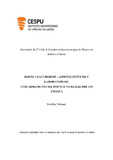Mostra i principali dati dell'item
DOENÇA FALCIFORME - ASPETOS CLÍNICOS E LABORATORIAIS. ENQUADRAMENTO DA DOENÇA NA REALIDADE EM ANGOLA
| dc.contributor.advisor | Coimbra, Carla Susana Meireles | |
| dc.contributor.author | Vikango, Serafim | |
| dc.date.accessioned | 2020-08-04T08:59:54Z | |
| dc.date.available | 2020-08-04T08:59:54Z | |
| dc.date.issued | 2020 | |
| dc.identifier.uri | http://hdl.handle.net/20.500.11816/3371 | |
| dc.description.abstract | The sickle-cell (SC) anemia is a monogenic hereditary disorder, characterized by the production of a pathological hemoglobin (Hb), called Hb S. Deoxygenation of this Hb leads to its polymerization, causing the formation of sickle cell, favoring ischemia and vascular occlusion, with acute pain, culminating in recurrent episodes of severe pain, anemia, severe infections, and injuries to vital organs. The occurrence of homozygosity or compound heterozygosity, the different haplotypes of Hb S, the levels of Hb F and the mutation for -thalassemia, influence the degree of SC disease (SCD) severity. For clinical diagnosis of SCD contributes the set of signs and symptoms that the patient presents, however, this has to be confirmed with laboratory diagnosis, through the detection of Hb S. It`s treatment is intended to minimize the specific complications, but implies also general health care. SCD is a condition that affects every year about 200 thousand children in Africa. In Angola, in 2016, about 3 million Angolans co-existed with this condition, and only in the Hospital David Bernardino, in Luanda, were diagnosed annually 1500 new cases. For this work, it was conducted an observational retrospective study that aimed to evaluate the impact of SCD in the hospitalizations associated with anemia, in the Regional Hospital of Huambo, the largest hospital of the central region of Angola, during the period of 2017 and 2018. In this period, there were 1641 cases of hospitalization for anemia, among which, 90.2% were cases of SCD (n=1480). Of the total cases of SCD hospitalization, 63% occurred in 2017 and 37% in 2018. The pediatric population, especially between 1 and 10 years of age, was the one in which there were more hospitalizations during the study period (34.1 % from 1 to 5 years, and 43.9% from 6 to 10 years of age); the male gender was the most affected, 72.9% and 62.7% of hospitalizations in 2017 and 2018, respectively. Among the complications that led to hospitalization, the vaso-occlusive crisis was the main cause (61%), followed by hemolytic episode (14%) and febrile syndrome (13%). The complications associated with SCD were the leading cause of hospitalization due to anemia in Huambo region. SCD is undoubtedly a critical health public problem in Angola. Therefore, it`s important to reduce the complications and the number of hospitalizations associated with SCD, the key for that seems to be the triad: prevent, treat and monitor | pt_PT |
| dc.language.iso | por | pt_PT |
| dc.rights | info:eu-repo/semantics/openAccess | pt_PT |
| dc.subject | Drepanocitose | pt_PT |
| dc.subject | Hemoglobina S | pt_PT |
| dc.subject | Crise vaso-oclusiva | pt_PT |
| dc.subject | Hospitalização | pt_PT |
| dc.subject | Prevenção | pt_PT |
| dc.subject | Tratamento | pt_PT |
| dc.title | DOENÇA FALCIFORME - ASPETOS CLÍNICOS E LABORATORIAIS. ENQUADRAMENTO DA DOENÇA NA REALIDADE EM ANGOLA | pt_PT |
| dc.type | info:eu-repo/semantics/masterThesis | pt_PT |
| dc.identifier.tid | 202506045 | pt_PT |
| thesis.degree.name | Mestrado em Análises Clínicas | pt_PT |

